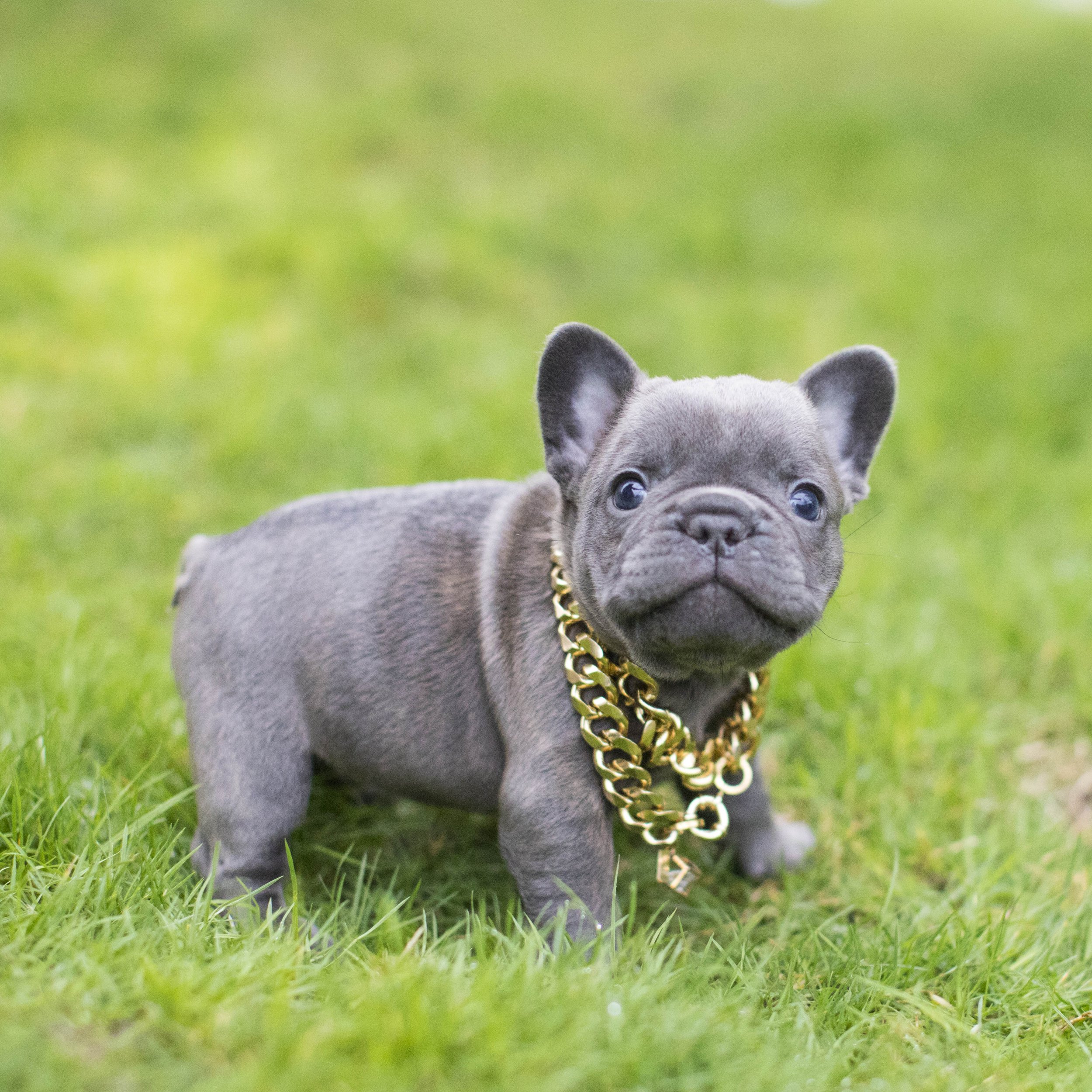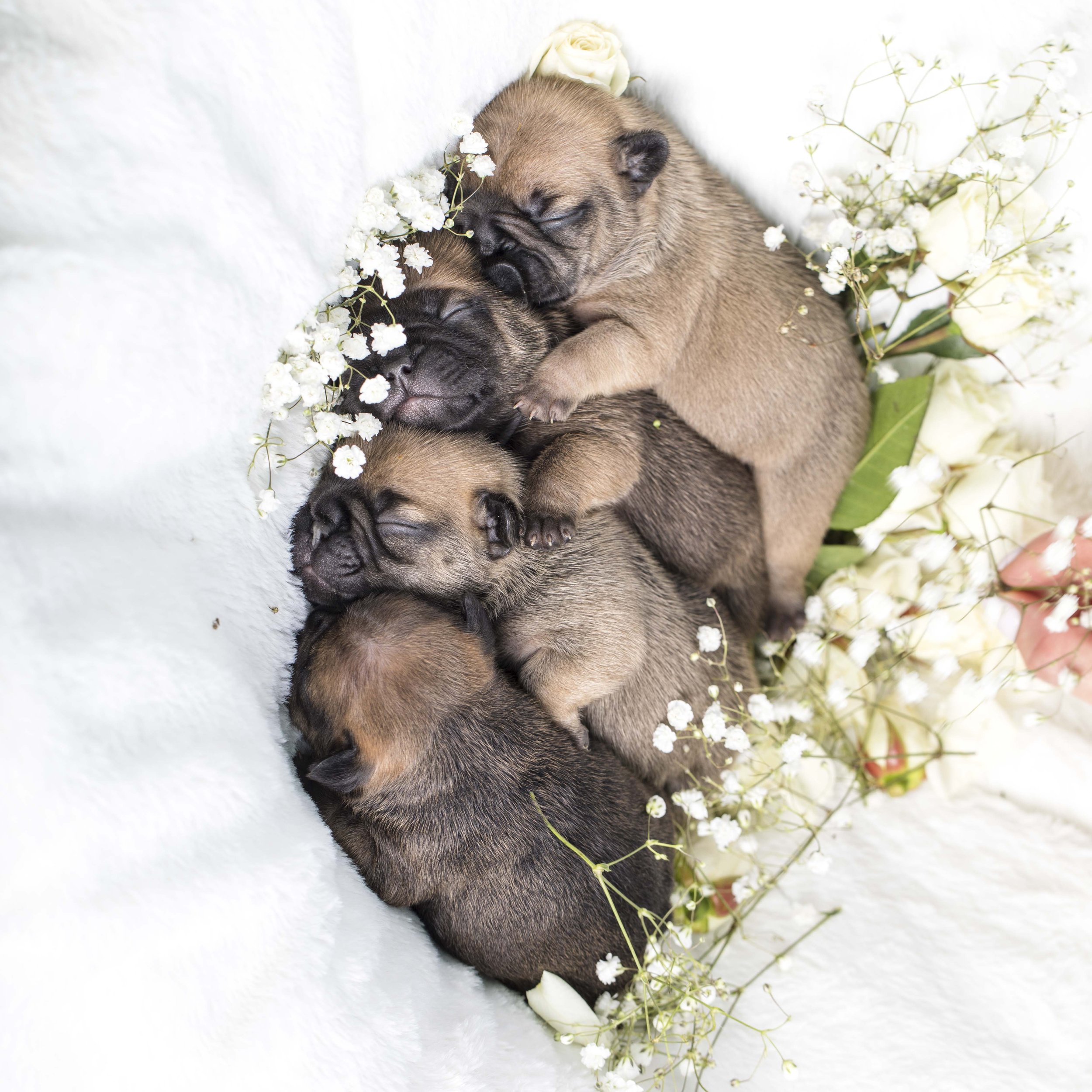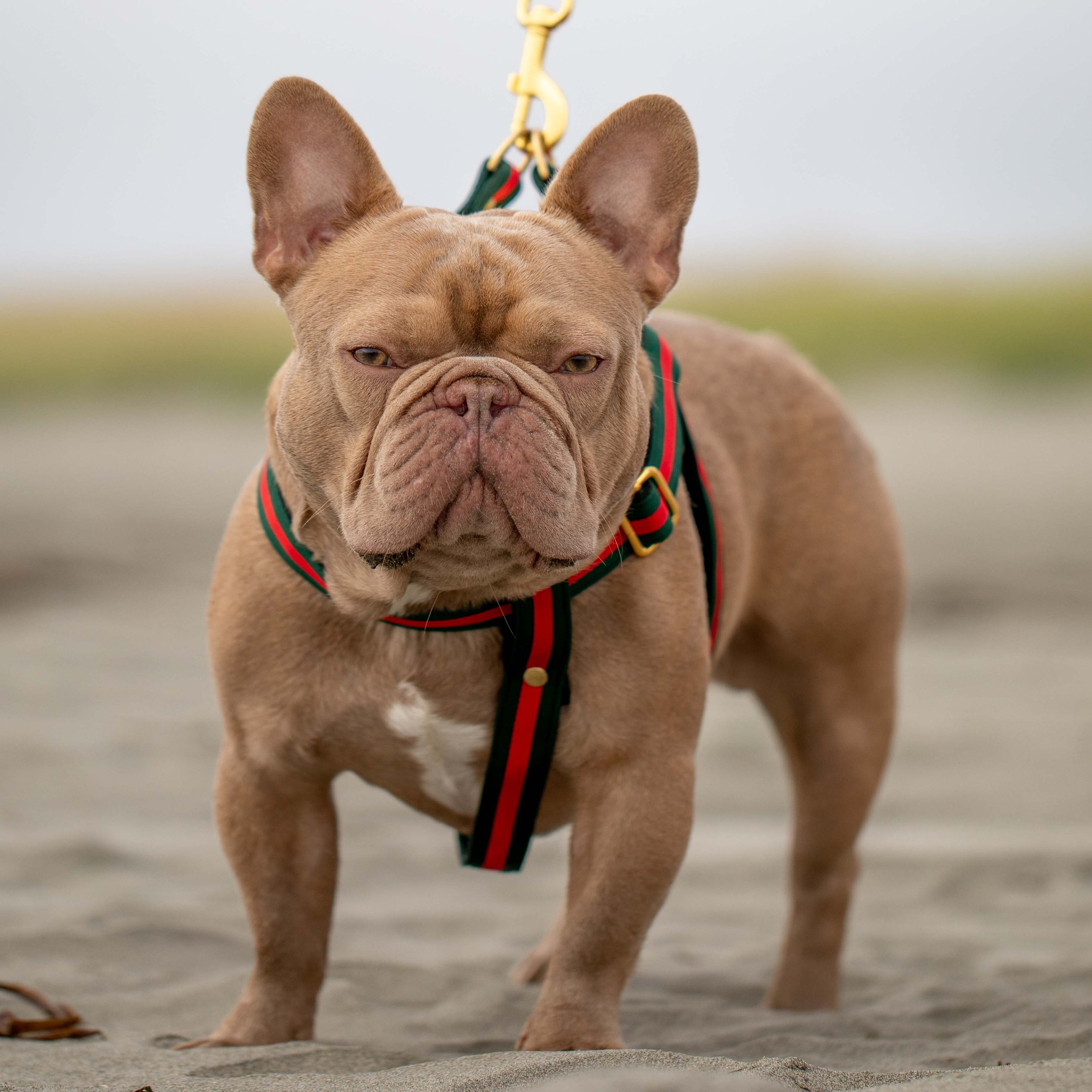Let’s first distinguish colors vs patterns. Colors in French Bulldogs are black, cream, blue, chocolate, cocoa, lilac, and Isabella. Patterns are brindle, pied, merle, fawn, tan points, and solid (aa).
One of the most common coat patterns is brindle. Brindle creates a striping effect on the coat and varies in its coverage. The color of the stripes are fawn (fawn is typically beige, but fawn can range anywhere from off-white to dark red). Some dogs have very minimal striping and some are what we call reverse brindle where the striping is so heavy that you mostly see the fawn. Brindle is inherited in a dominant manner, so it only takes one copy of the gene to produce this coat pattern. Any coat color can display the brindle pattern over top. For example, black brindle, cocoa brindle, chocolate brindle, lilac brindle, and Isabella brindle. Genetically, this is the “Kbr” locus. KbrKbr and KbrN is a brindle dog. NN is a non-brindle dog.
This is a blue brindle puppy. You an see the faint stripes of fawn popping through the dark grey base coat. Brindle is easier to spot on the sides of the body and legs compared to the head.
Brindle puppies are typically born looking as if they are solid in color. However, as they start to grow the brindle striping becomes more apparent. My foundational female had two copies of brindle, however didn’t show any brindle even as an adult despite being ayay for her agouti locus. Many of her offspring also had brindle that looked nearly solid, while a few brindles were born with the apparent stripes that this pattern is known for.
The second most common coat pattern is pied. Pied breaks up the coat into spots separated by a white base coat. The areas that receive color can be predicted in the offspring based on where the parents patterns were. Some pied dogs retain most of their coat color and this is called an Irish pied. Some pied dogs have so little color retained that they appear nearly completely white- we call this extreme pied. There are some health concerns surrounding the pied coat color especially in extreme pied dogs. When the areas around the ears and eyes lack pigment these dogs can be at risk of being born congenitally deaf, and though uncommon sometimes with diluted icy-blue eyes (lack of pigment in the eyes). So it is favorable to select breeding stock with a good amount color on the head, at least if breeding pied in your program. Pied is typically inherited in a simple recessive manner, meaning you need two copies (one from mom, and one from dad) to produce this coat pattern. I have come across a small number of dogs that display a pied pattern but only carry one copy of the pied gene or even no copies of the gene- this is very rare and not yet understood, nor do we have the genetic testing available to distinguish the responsible gene. Pied can be combined with other coat patterns, such a brindle and merle. Genetically pied is the “S” locus. SS and Ss is a non-pied dog. ss is a pied dog. Again, pied is a coat pattern- not a coat color. So you can have a black pied, blue pied, cocoa pied, etc, dog.
This is Grand Champion Peerless Hannibal owned by Jacqueline Rose Salgado.
This dog is a lilac fawn irish pied, owned by Peerless French Bulldogs in Texas. This French Bulldog has excellent head pigmentation. Both the eyes and the ears are completely covered in color.
Merle is a coat pattern that breaks up the coat color into splotches. Merle is a deletion gene, meaning it deletes pigment from the coat in a random fashion. Merle is inherited on a spectrum. Some dogs display only small cracks in the coat color while some dogs coats are deleted so much that only small dots of the original coat color remains. Merle is also a dominant gene, meaning it only takes only one copy to display this coat pattern. It is advised to never breed a merle dog to a merle dog due to health concerns in the offspring. These health concerns mirror those of extreme pied dogs. When too much pigment is deleted from the eyes and ears in double (one merle gene from mom, and one merle gene from dad) merle dogs, they can be born deaf, blind, and even missing eyes in the most severe cases. There are no known health concerns with breeding a merle dog to a non merle dog with regards to the double deletion- as only one deletion will happen as only one parent is merle.
As mentioned, the areas that are affected by this coat pattern are random. If the merle pattern randomly lands over the eyes one time, it turns the iris an icy crystal blue. Sometimes only one eye is affected by the merle gene and you get a dog with one blue eye and one hazel eye. This is called heterochromia. Furthermore, it’s common that only a portion of the eye is affected by the merle gene and so you have a regular hazel iris with just a spot of blue randomly. The merle coat pattern can combine with any other coat pattern as mentioned previously with pied and brindle. Merle over a black coat typically deletes the pigment to an off white. Merle over a cocoa or chocolate coat deletes the pigment to a beige. Merle over a blue coat deletes the pigment to a light grey. And Merle over a lilac coat deletes the pigment to an off-white/very light grey. Genetically, this is the “M” locus. MM is a non-merle dog, and Mm is a merle dog. mm is a double merle dog.
This dog is a blue and tan merle. You can see that her left eye is just partly icy-blue.
This dog is a lilac fawn merle with heterochromia. She does have splotches over her body as well, though faint as the base coat color of fawn is a light beige as is, and is diluted to a white in the areas that merle deleted pigment.
The “a” or agouti locus encompasses three distinct genes. “ay” is the fawn or sable gene, “at” is the tan points gene, and “a” is the recessive solid black gene (or solid gene). Fawn (ay) a hue of beige, anything from a very light off-white, to a deep red fawn is possible. The hue of fawn inherited is dependent on a separate gene called the intensity dilution gene “In” locus.
Let’s take one moment to interject with the intensity dilution gene before we move on with the rest of the agouti locus. This gene is called intensity DILUTION. Meaning, when the dog has one copy the hue of fawn is diluted from red to beige. Two intensity dilution genes create a very light beige fawn. All too often I read forums of breeders discussing the “intensity” gene and they leave out the other half of the name- which makes it sound like the gene is doing the opposite of what it does! So don’t forget that carrying intensity dilution makes the fawn less intense. InIn is a deep red. InN is a medium red. And NN is a light beige.
This puppy is a standard black masked fawn. This is the most common hue of fawn seen in French Bulldogs- the beige fawn,
This is a standard black masked fawn with a red hue of fawn. This color is also referred to as just red fawn.
Fawn (ay) can be modified by sable. Fawn and sable are somewhat interchangeable as sable is inherited and displayed on a gradient. When sable is minimal or non existent visually we call the dog fawn. When a breeder decided to call a dog a sable vs a fawn is up to their individual discretion. Sable will take whatever base coat color the dog is (i.e., black, cocoa, chocolate, blue, lilac, isabella) and add those darker hairs mainly along the back and face. Sable can be so widespread that the dog appears tan pointed or even solid in color. Again, as mentioned fawn/sable can be displayed over any base coat color, for example a black fawn (also referred to as a standard fawn) will have a black nose/eye rims and a varying hue of fawn hairs on the rest of the body. Cocoa and chocolate fawns will have dark brown and brown noses/eye rims. Blue fawns will have dark grey noses/eye rims. Lilac fawns will have light grey noses/eye rims, and Isabella fawns will have peanut butter colored noses/eye rims. Typically standard black fawns and sables have the deepest hues of red (when selected for red). While the most diluted coat colors such as lilac and Isabella have a lighter beige fawn. My hypothesis from years of breeding is that the least diluted coat colors (black) have more pigment in the hairs to begin with- not just in the black hairs but in the fawn hairs as well. Which is why I have seen super super dark red standard black fawns (with black noses), and only orange, at most, fawns in lilacs (with light grey noses).
These puppies could all simply be referred to as standard fawns, or sables. Or one might call them starting from the left: red fawn, standard fawn, sable, red sable,
Another angle showing how sable covers the coat vs fawn. From top to bottom I would call these puppies standard fawn, red sable, sable, and red sable. Again, its up to the breeders discretion. We could simply call them all fawn or all sable as well.
The second allele on the agouti locus is the tan points gene, “at”. Tan points is a recessive gene and requires two copies to make the pattern. Tan points create lighter socks, chest, eyebrows, and cheeks over the base coat color of the dog. The color of these features is the color that the dog would have been as a fawn (anything from nearly white, to a red/orange). The remainder of the dog is their base coat color (i.e. black, cocoa, chocolate, blue, lilac, Isabella).
This dog is cocoa and tan., Owned by Calihouse Frenchies in California.
This dog is lilac and tan and also carries brindle. The tan points are muddled as the brindle gene covers them up. Tan and brindle dogs are also referred to as trindles.
The third allele on the agouti locus is the solid or recessive black “a” gene. Solid is a recessive gene and requires two copies of the gene to display the coat pattern. This “pattern” makes the coat solid (no other patterns will show up in a solid “aa” dog, including brindle, pied, and merle- the only gene that can override aa is cream.) And so, we have one locus with three possible genotypes, meanings we have 2 x 3 genetic combinations that can fill this gene. Ay is dominant to at, which is dominant to a.
Ay/ay = fawn/sable
ay/at = fawn/sable
ay/a = fawn/sable
at/at = tan points
at/a = tan points (sometimes less prominent tan points due to the a)
aa = solid
This dog is solid lilac aa. There are no stripes from brindle, tan points, nor fawn/sable markings. This is a solid coat. Only merle and cream are dominant to solid aa, and can modify the coat. Otherwise solid aa makes a spotless stripless coat and is my personal favorite to work with.
Moving right along! Is your brain fried yet!? Or do you love coat color genetics as much as I do
The e locus is similar to the a locus, where it also has three possible genes. The first is Mask “Em”, maskless “E”, and cream “e” Mask is dominant to maskless, which is dominant to cream. As you may have guessed by the name, the mask gene puts a mask over the nose and mouth of the dog. We see a mask most easily in fawns and tan pointed dogs. Although cream is recessive, once you get two copies of the gene, it will cover up every other coat pattern and color in cream, and that is all you will see. Creams typically are white, though I have also very rarely seen yellow, and orange creams as well.
Em/Em = mask
Em/E = mask
Em/e = mask
E/E = maskless
E/e = maskless
e/e = cream
This dog is a lilac fawn.
This dog is a maskless lilac fawn.
This puppy is a cream.
Finally, we get to the base coat colors- black, blue, chocolate, cocoa, lilac and Isabella. Black is the “standard” fully pigmented coat color. Each one of these other colors are simple recessive and dilute the pigment and produce a lighter coat.
This puppy is a solid aa black.
This puppy is blue brindle.
Blue, also known as the dilute gene is designated by the “d” locus. Blue is recessive and requires two copies to modify the coat into a dark grey. DD and Dd is not a blue dog, and dd is a blue dog.
This puppy is chocolate brindle.
Chocolate is designated by the “b” locus. The genetics companies will refer to this as the brown gene. Though among French Bulldog breeders we now just call it chocolate. Chocolate is a recessive gene and requires two copies to modify the coat into a medium brown. BB and Bb is not a chocolate dog, and bb is a chocolate dog.
This dog is cocoa brindle.
Cocoa is designated by the “co” locus. Cocoa is a recessive gene and requires two copies to modify the coat into a dark brown. COCO and Coco is not a cocoa dog, and coco is a cocoa dog.
This dog is lilac brindle.
When a dog is both blue and cocoa at the same time, we refer to this double diluted color as lilac. Lilac itself is not a gene- rather a combination of two genes. Genetically lilac is “coco dd”. Anything other than “coco dd” is not lilac.
This dog is an isabella brindle.
When a dog is both blue and chocolate at the same time, we refer to this double diluted color as Isabella. Isabella itself is not a gene- rather a combination of two genes. Genetically Isabella is “dd bb”.
When is dog is both chocolate and cocoa at the same time, we refer to this double diluted color as double chocolate, genetically “coco bb”. Sadly, I have no photo of a double chocolate to share with you today. But I hope to add one in from my own productions in the near future!
This puppy is a New Shade brindle
Finally, you can have a dog that is simultaneously cocoa, chocolate and blue. French Bulldog breeders refer to this triple diluted coat color as “new shade” although I personally thing that champagne would have been a more fitting name. Genetically this is “dd bb coco”
There are so many combinations of colors and patterns, all with predictable results based on if they inherit in a dominant or recessive pattern. If you have the full color panel of both the mother and the father dog, you can predict exactly what colors and patterns their puppies will be born in.
This is a cream long haired puppy.
One last bonus topic I would like to discuss is the long hair gene. In French Bulldogs we have L1 and L4. L1 vs L4 doesn’t affect the length, thickness or curl of the hair. It will simply make long hair. Long hair is a recessive gene and requires two copies of the gene to result in long hair.
Thank you for sticking around for one of my favorite topics. If you have future questions, please post your comment below and I will read and respond! Lots of love and hugs from NW Frenchies XOXO





















